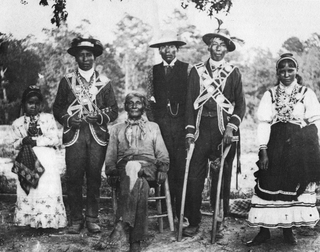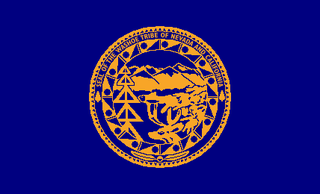Related Research Articles

The thunderbird is a mythological bird-like spirit in North American indigenous peoples' history and culture. It is considered a supernatural being of power and strength.

Choctaw mythology is part of the culture of the Choctaw, a Native American tribe originally occupying a large territory in the present-day Southeastern United States: much of the states of Mississippi, Alabama, and Louisiana. In the 19th century, the Choctaw were known to European Americans as one of the "Five Civilized Tribes" even though controversy surrounds their removal.

Mythology of the Haudenosaunee includes the creation stories and folktales of the Native Americans who formed the confederacy of the Five Nations Iroquois, later the Six Nations Iroquois Confederacy. Historically, these stories were recorded in wampum and recited, only being written down later. In the written versions, the spellings of names differ due to transliteration and spelling variations in European languages that were not yet standardized. Variants of the stories exist, reflecting different localities and times.
The Abenaki people are an indigenous peoples of the Americas located in the Northeastern Woodlands region. Their religious beliefs are part of the Midewiwin tradition, with ceremonies led by medicine keepers, called Medeoulin or Mdawinno.

Lake Tahoe is a freshwater lake in the Sierra Nevada of the Western United States, straddling the border between California and Nevada. Lying at 6,225 ft (1,897 m) above sea level, Lake Tahoe is the largest alpine lake in North America, and at 122,160,280 acre⋅ft (150.7 km3) it trails only the five Great Lakes as the largest by volume in the United States. Its depth is 1,645 ft (501 m), making it the second deepest in the United States after Crater Lake in Oregon.

The Indigenous peoples of the Americas comprise numerous different cultures. Each has its own mythologies, many of which share certain themes across cultural boundaries. In North American mythologies, common themes include a close relation to nature and animals as well as belief in a Great Spirit that is conceived of in various ways. As anthropologists note, their great creation myths and sacred oral tradition in whole are comparable to the Christian Bible and scriptures of other major religions.
Chamrosh is a bird in Persian mythology said to live on the summit of Mount Alborz.

The simurgh is a benevolent bird in Persian mythology and literature. It bears some similarities with mythological birds from different origins, such as the phoenix and the humā. The figure can be found in all periods of Iranian art and literature and is also evident in the iconography of Georgia, medieval Armenia, the Eastern Roman Empire, and other regions that were within the realm of Persian cultural influence.

The Washoe or Wašišiw are a Great Basin tribe of Native Americans, living near Lake Tahoe at the border between California and Nevada. The name "Washoe" or "Washo" is derived from the autonym Waashiw in the Washo language or from Wašišiw (waší:šiw), the plural form of wašiw.

Washo is an endangered Native American language isolate spoken by the Washo on the California–Nevada border in the drainages of the Truckee and Carson Rivers, especially around Lake Tahoe. While there are only 20 elderly native speakers of Washo, since 1994 there had been a small immersion school that has produced a number of moderately fluent younger speakers. The immersion school has since closed its doors and the language program now operates through the Cultural Resource Department for the Washoe Tribe. The language is still very much endangered; however, there has been a renaissance in the language revitalization movement as many of the students who attended the original immersion school have become teachers.

The lightning bird or impundulu or thekwane is a creature in the folklore of the Zulu people.
Water Babies are spirits featured in the folklore of several Western Native American tribes, particularly among the Great Basin Indians. These entities are believed to inhabit bodies of water such as springs, ponds, and streams, often appearing as infants whose cries are considered an omen of impending disaster. In some traditions, they are described as small creatures who lure people to their deaths and are said to eat children.
Mythic humanoids are legendary, folkloric, or mythological creatures that are part human, or that resemble humans through appearance or character. Each culture has different mythical creatures that come from many different origins, and many of these creatures are humanoids. They are often able to talk and in many stories they guide the hero on their journey.
Tahoe Tessie is a cryptid said to inhabit the depths of Lake Tahoe, a lake that straddles the border between California and Nevada. Reports of Tessie date back to the mid-1800s, and over time, the creature has become a well-known part of local folklore.
The Raven Mockers are feared entities in Cherokee mythology. These figures, referred to as witches, are believed to extend their lives by preying on the sick and dying. They are described as withered and aged, flying through the sky in fiery forms, emitting sounds similar to the call of a raven. After tormenting their victims, they consume their hearts, gaining the remaining years of the victim's life. Raven Mockers are invisible to most people, but skilled medicine men are able to see or repel them. Once recognized, a Raven Mocker is said to die within seven days.
References
- 1 2 3 Cachinero, Eric (November–December 2019). "The Legend of Lake Tahoe" . Retrieved September 15, 2024.
- 1 2 3 Moonshine Ink Staff (June 14, 2018). "Tahoe myths: Tessie and the man-eating lake bird, Ong" . Retrieved September 15, 2024.
- 1 2 3 4 5 6 7 8 9 Jones, Allison (November–December 2018). "Lake Legends of Wa She Shu" . Retrieved September 15, 2024.
- 1 2 3 Porter, Jim (March 24, 2024). "A Washoe Tale: The Legend of Tahoe" . Retrieved September 15, 2024.
- 1 2 "The Washoe Tribe: Guardians of Lake Tahoe". 14 June 2024. Retrieved September 15, 2024.
- 1 2 Unruh, Trent (16 February 2022). "The Washoe Tribe and Their History Around Lake Tahoe" . Retrieved September 15, 2024.
- 1 2 3 4 5 Mills, Quintin (April 9, 2024). "Tahoe Lore: Underneath the Surface" . Retrieved September 15, 2024.